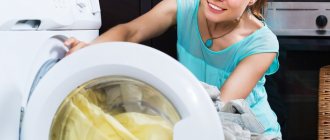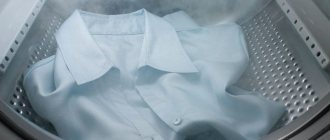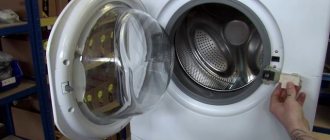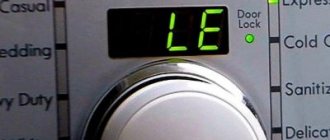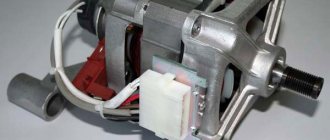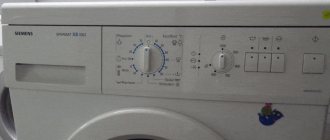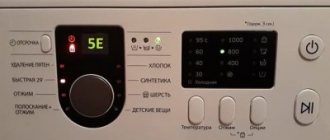Causes and signs of fungus
Mold appears on the inside of the washing machine if:
- poor ventilation in the room;
- air humidity is exceeded;
- washing is carried out at a temperature of 40–60 degrees.
Often, fungus develops if the drum and trays are not wiped dry after use and the unit door is tightly closed to prevent air from entering.
It is necessary to clean the washing machine from mold when the following is found:
- black spots in the powder compartment, on the rubber gasket;
- musty smell on items of clothing after washing.
It is important to quickly remove mold, since the fungus poses a danger to people, reducing immunity, causing inflammatory processes, and chronic bronchitis.
Before removing mold, check where exactly the fungus is growing. They inspect the hoses, filter, rubber seal at the door, and container.
Black mold spots
Mold is characteristic black dots, which then gather into islands, grow, and thicken. Fungus in washing machines is formed as a result of improper care, ignoring the need for preventive cleaning and rinsing.
What is the danger
Fungal spores are present in significant quantities in atmospheric air masses. For example, a perfectly washed apartment only seems so, since for every cubic meter there are 500 mold spores. Constant inhalation causes chronic rheumatic pain, migraines, allergies, and asthma attacks. If the immune system is normal, there may be no unpleasant consequences; when it is weakened, unwanted reactions always appear.
Fungus loves:
- high temperatures (heat);
- dampness;
- lack of normal ventilation.
Both the mold itself and the factors that caused it need to be eliminated. If you don't do this, the problem will progress. Machines installed in bathrooms are a priori at risk, since it is very humid here. But it’s one thing to wash the tiles and another thing to clean the insides of the washer.
Causes
Black spots of mold in the washing machine appear in the absence of proper care and incorrect operation, namely:
- Regular quick washes - “express mode” is fast and saves time, but it is low temperature. This means that the drum is not normally disinfected at all. 60 degrees kills mold on its own, and 30-50 literally creates fungal colonies.
- The use of laundry detergents without bleaches - that is, active ingredients that prevent the appearance of mold. If you use only gentle gels, powders without chlorine and phosphates, fungus will appear quickly.
- Conditioner without additional rinse - rinse aid softens fabrics, makes them soft, but requires longer washing. Poorly washed fabric softener forms a bluish coating on the walls of the washing machine - an ideal environment for fungus.
You can get back the lost time - remove any mold that appears, and in the future use the washing machine correctly.
Signs of appearance
To remove fungus, determine its habitat. Mold loves:
- rubber seals;
- dispenser trays;
- hoses.
First, try to remove the mold with soap or powder and a brush. Then treat problem areas with an anti-fungal compound (you can buy it at any hardware store). There are special chemicals for treating washing machines - please note. Check the walls of the tank - mold is less common there, but it also happens.
How to clean mold from a washing machine using ready-made products
Domestos antifungal agent and others like it will help clean your washing machine.
Before processing, wear personal protective equipment: thick waterproof gloves, a mask made of three layers of gauze. The composition is applied to all internal parts using a napkin or brush and left for three hours.
Wipe the surfaces with a hard sponge, rinse three times with clean water, and wipe with a dry cloth. Used materials are wrapped in a plastic bag and thrown away. This technique is used to get rid of harmful fungus that develops on surfaces accessible for treatment. If it is localized inside hoses and filters, then disinfection will be required.
We recommend reading: How to clean a sofa from dust and stains yourself
What is mold and why is it dangerous?
Mold stains are colonies of very small fungi. If you look at them through a microscope lens, you can see threads (mycelium) and thickenings at their ends (spores). The latter are separated from the mother's body and travel with the air flow.
Mold spores can be found both outdoors and indoors. Hiding and not showing themselves in any way, they bide their time.
When favorable conditions occur, such as high humidity and warmth, the spores germinate quickly. As a result, colonies are formed, which are dark spots on some objects.
Colonies of mold fungi are easy to notice on the surface of washing machine parts. They look like dark spots of varying sizes, covered with gray fluff.
In nature, mold lives almost everywhere. These fungi play a very important role in the cycle of substances, helping to utilize organic residues.
Man has learned to synthesize a medicine from them, which has saved millions of lives.
However, despite some positive characteristics of these tiny creatures, having them in your home is extremely undesirable. In addition to the presence of an unpleasant odor, inhalation of large quantities of fungal spores can lead to acute and chronic diseases
Mold produces a special toxic substance - mycotoxin . Penetrating into the human body in various ways, it causes the following symptoms:
- in case of contact with skin – irritation and itching;
- getting into the respiratory system - cough and shortness of breath;
- penetrating the gastrointestinal tract and disrupting the functioning of the normal microflora present there - bloating, diarrhea, constipation;
- absorbed into the bloodstream and entering nerve cells - weakening of attention and memory.
Therefore, if colonies are discovered in the house, you should immediately begin to destroy them.
How to get rid of mold in a washing machine using bleach
The process is multi-stage.
- First, in order to remove mold, household chlorine bleach, for example, Whiteness, is poured into the powder compartment.
- Set the temperature to 90 degrees.
- Start the wash. After half an hour, press pause.
- Leave the drum with water for three to four hours until all parts are completely clean.
- Continue washing.
- When rinsing, add 9% vinegar - three glasses - to the conditioner compartment.
At the end of the procedure, wipe the parts with a dry soft cloth. The machine door is opened for 24 hours. Remove and dry the container.
How to clean mold from a washing machine with copper sulfate
A solution of copper sulfate, which is used according to the scheme, reliably removes mold from the washing machine.
- A teaspoon of copper sulfate is stirred in a glass of warm water until completely dissolved. Leave for two hours for final infusion.
- Strain through double gauze to eliminate the presence of particles that could damage rubber parts.
- Use a sponge to distribute the solution over the cuff and leave the mixture for a day.
- Dissolve two tablespoons of washing powder in a liter of water.
- By moistening a napkin in this solution, they begin to wash away traces of vitriol along with contaminants. Hands are protected with gloves.
- Having finished disinfecting the cuff, pour three sachets of lemon juice into the powder compartment, place two clean pillowcases in the drum and set the washing mode for cotton linen to 90 degrees.
When washing is complete, wipe the insides with a dry cloth. This cleaning will remove black mold marks and, thanks to citric acid, eliminate mustiness.
Having noticed a black coating in the containers, remove the tray and rinse under running water. Then dip the toothbrush in the cleanser and scrub the surfaces. Wash with clean water and dry.
Mold smell in the washing machine: how to get rid of it with citric acid
When deciding how to remove the smell from a washing machine, they resort to acid.
- Domestos is applied to the drum and rubber cuff with a hard sponge.
- Close the machine door.
- After 4 hours, wash off the remaining drug by rinsing.
- After turning off the unit, place three tablespoons of lemon juice into the powder compartment and wash at maximum temperature.
After this treatment, mold stains, mustiness and scale formed on the heating elements disappear.
The same home method is also used. Combine citric acid and washing powder in equal volumes. Add water, stirring the mixture until it reaches the consistency of a thick slurry. Apply to the inner surfaces of the drum, cuff, and distribute inside the tray. Rub with a sponge and close the machine for a day. To remove remaining dirt, set the rinse mode, then quick wash.
Why does fungus appear?
Fungal colonies can grow rapidly, so to successfully combat them you need to understand the causes of the problem:
- High humidity . This refers to both dampness in the room where the unit is installed and in the washing machine itself. An unwashed and undried washing powder container and improper care of the drum and sealing rubber provoke the appearance of mustiness and mold.
- Incorrect use of rinse aid . After washing with fragrances, it is necessary to turn on the unit for an additional rinse. Fabric softener leaves an oily film on surfaces, which serves as a comfortable environment for mold.
- Washing with powders without bleaches . Products with bleaching particles have disinfectant properties - they fight bacteria and fungus.
- Quick wash in cold water . The short mode, beloved by housewives, saves time and electricity, but at the same time harms the device. At low temperatures, the machine remains for a long time without disinfection, and low temperatures contribute to the appearance of mold. Periodically it is necessary to wash things at temperatures not lower than 60 °C.
- Tightly closed lid . There is no ventilation in the drum, the surfaces do not dry out, remaining constantly wet.
Advice! In addition to the universal powder, also buy bleaching powder. It is enough to use it a couple of times a month to keep the machine clean.
Prevention
To prevent the development of mold, do not forget about prevention.
- Every month, instead of powder, citric acid is added and a washing cycle without items is started.
- After using rinse aids, the tray is washed immediately.
- Each wash is completed by thoroughly wiping the drum with a terry cloth.
- Do not store dirty clothes in the drum.
- Perform one wash every month with bleach powder at maximum temperature.
- Filters and hoses are regularly disinfected.
Washed clothes should not be left in the drum for a long time; they should not be removed immediately. It is not recommended to frequently use conditioners and gel detergents - they are not completely washed out. If the washing machine is installed in the bathroom, you need to regularly ventilate the room.
The musty smell emanating from items after washing requires immediate removal of mold from the unit. To do this, they use proven and reliable methods that show high results.
What threatens
The presence of mold deposits leads to a number of negative problems. The fungus creates inconvenience during everyday use of the washing machine and causes malfunctions.
Allergic reactions
The mold that forms in the drum gets onto your clothes, creating a health hazard. The fungus produces mycotoxins, which when interacting with the skin lead to allergic reactions.
Weakening of the immune system
Contact with mold also weakens the human immune system. As a result, viral diseases arise, general health worsens, and fatigue occurs.
Unpleasant smell
The development of fungus causes a sharp, unpleasant odor that can be felt when opening the door or detergent compartment.
An unpleasant odor not only causes constant discomfort when using the washing machine, but also permeates clothes, which leads to their damage.
